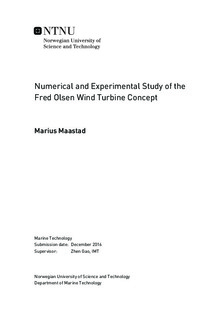Numerical and Experimental Study of the Fred Olsen Wind Turbine Concept
Master thesis
Permanent lenke
http://hdl.handle.net/11250/2615007Utgivelsesdato
2016Metadata
Vis full innførselSamlinger
- Institutt for marin teknikk [3421]
Sammendrag
In this Master's thesis the numerical model designed by Fred. Olsen (FO) is improved, and a long-term analysis for design checks is performed.
The hydrodynamic loads for the numerical model were initially based on Morison's formulation, while the hydrodynamic loads for the improved model are based on Linear Potential Theory (LPT) formulation. The Morison's and numerical LPT model are judged according to a comparison study with experimental results. The experimental results are valid for heave motions, while results for pitch motions are questionable. This is due to the inadequate measurement set up, during the experiment. The Morison's formulation gives a poor representation of the experimental results. An LPT formulation is, in general, a better choice. The latter results in an adequate representation of the heave motions, while the description of the pitch motions is unsatisfactory. The natural periods for linear and nonlinear motions are, respectively, 3.4 and 4.4 s for heave, 7.5 and 9.0 s for pitch and 6.9 and 10.6 s for heave with heave plates.
The Fatigue Limit State (FLS) design check requirement is violated. For heave with and without heave plates, the cumulative fatigue damage is 122.9 and 172.4, respectively. The structure is vulnerable for a wave heading of 90 degrees without heave plates, while the case with heave plates is more robust. The large fatigue damage occurs due to the structural natural periods being within the 1$^{st}$ order wave frequency interval.
The Ultimate Limit State (ULS) requirements are, in terms of buckling, violated for all cross-sectional orientations. ULS, in terms of yield, is only satisfied designed for the orientation which is not affected by the wind- and wave- induced bending loads.
A re-design of the foundation is recommended for future work, to change the structural natural periods and enhance the hydrodynamic performance.
